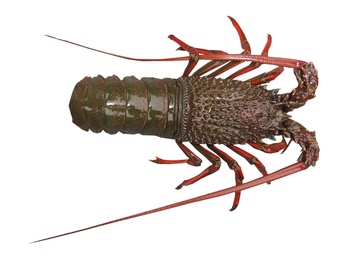Eastern rock lobster
Sagmariasus verreauxi

(Image credit: Antonia Cooper)
This species is more common to New South Wales and is captured regularly in north-eastern regions of Tasmania in small numbers. Some fishers report seeing the occasional specimen around south-western Tasmania and since 2020 they have been reported from eastern South Australia. Mature female eastern rock lobsters have not been reported from Tasmania. Larvae are thought to be delivered into Tasmanian waters via the East Australian Current.
The eastern rock lobster is faster growing than the southern rock lobster and reaches larger sizes, with females maturing at around 165 millimetres. It is the largest rock lobster in the world. It does not start producing eggs until it reaches 2 kg, about double the size of southern rock lobsters.
The eastern rock lobster has a similar appearance to the southern rock lobster, although the body is green with orange/brown legs.
AKA: Green rock lobster
Length: Carapace up to 26 cm
Habitat
Exposed reef; 0-220 m depth
Log it
Log this species wherever it is spotted in Tasmanian waters or South Australian waters.
Related links/info
Species names on the Redmap site are based on the Codes for Australian Aquatic Biota or CAAB http://www.cmar.csiro.au/caab/ This is updated regularly and lists the approved common name, family, species name and more.
Redmap species descriptions were based, with permission, on the following books:
Australian Marine Life: The Plants and Animals of Temperate Waters by G. J. Edgar, Revised (2008 ) Reed Books, Melbourne
Fishes of Australia’s Southern Coast, Edited by M. Gomon. D. Bray and R. Kuiter (2008) Reed Books, Melbourne
Fishes of Tasmania by P. Last, E. Scott and F. Talbot (1983). Tasmanian Fisheries Development Authority, Hobart











